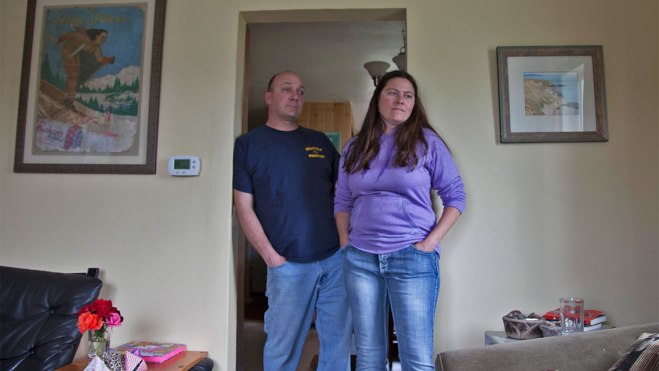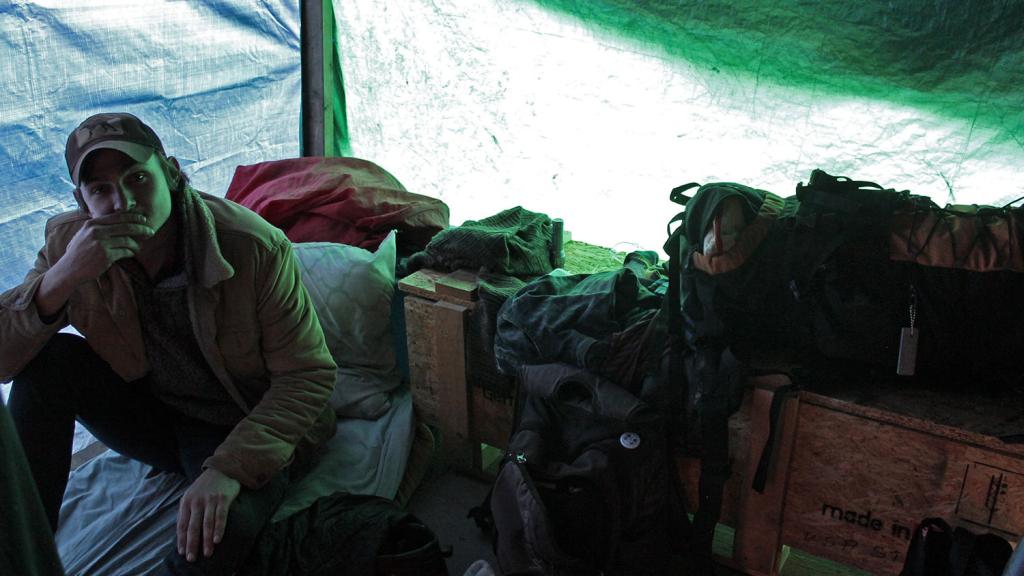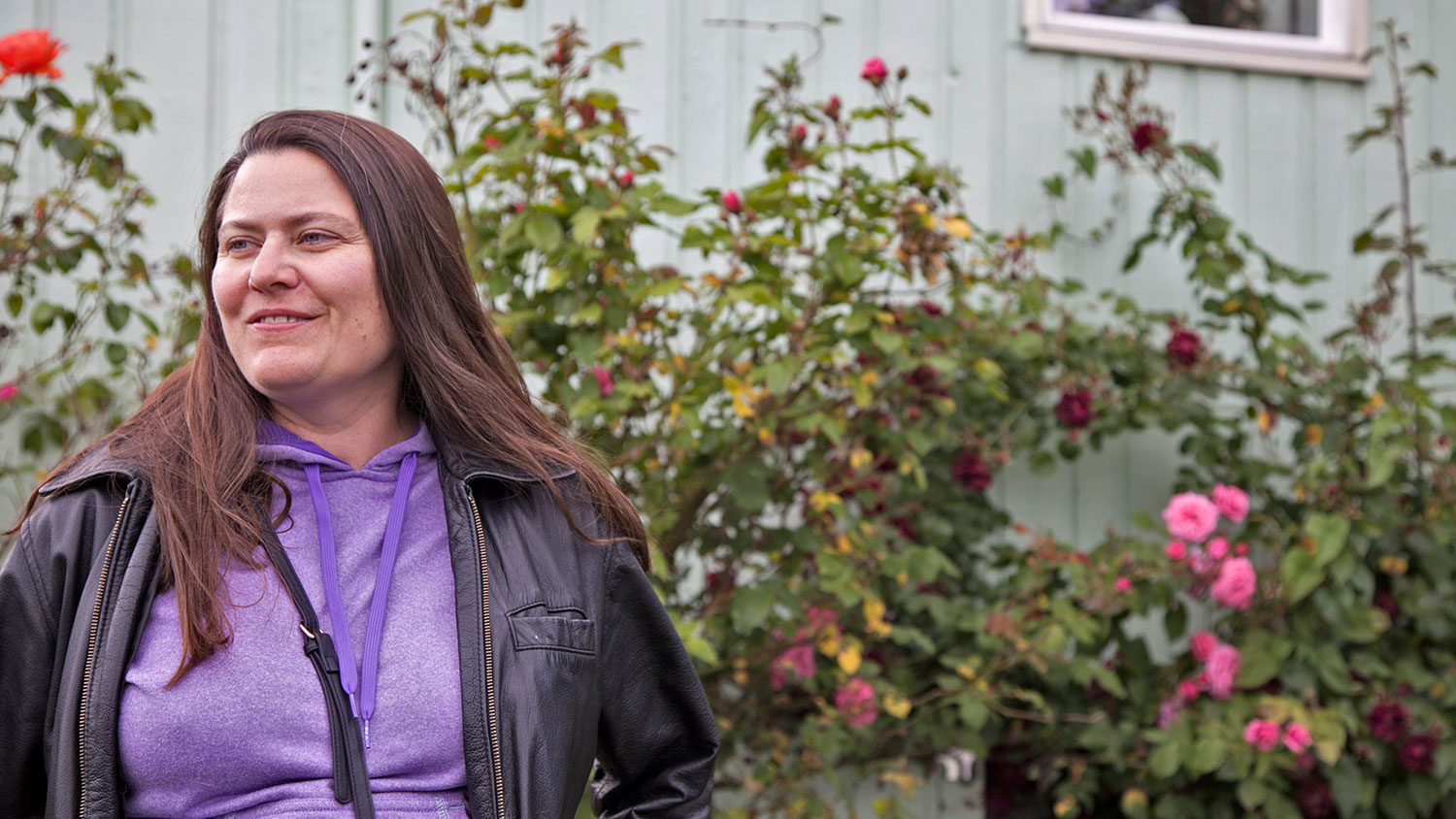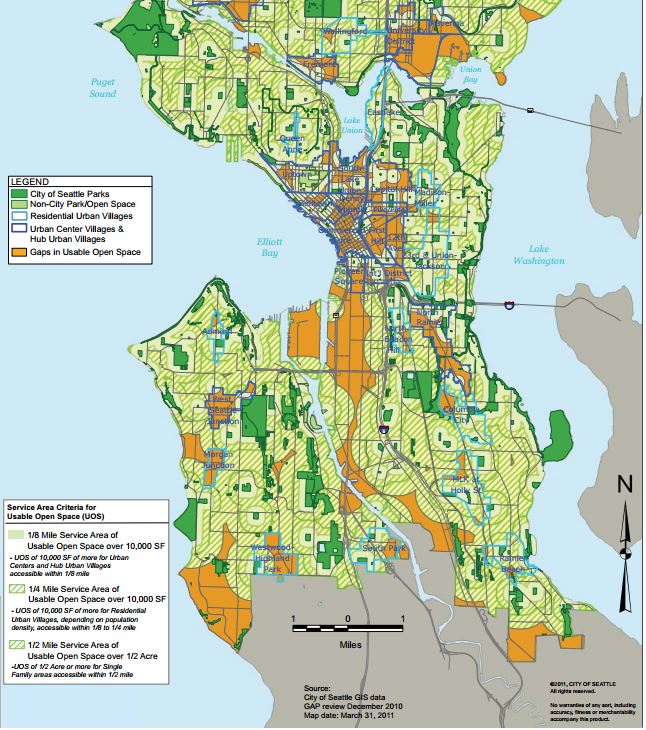DeVona Lahrman, 49, lives in a little, green house with a double-lot yard where a tire swing hangs from a 100-year-old apple tree. In the summer, the yard is filled with neighborhood kids; they show up at the fence in the morning and stay until evening for a bite to eat. They toss around softballs, play tag, and dig in the garden where Lahrman plants herbs and organic vegetables.

Lahrman’s daughter, Holland, 12, swings on the tire swing, facing a manufacturing plant across the street. Grist / Amelia Bates
Zoom out from this seemingly quaint city scene, and you’ll see why children come from blocks away. Across the street from Lahrman’s house is a heavy-duty hardware manufacturer; a few blocks west, State Highway 99 rumbles with constant traffic; and the nearby Duwamish River is lined with factories and barges. The closest public park, South Park Playground, is nearly a mile away from Lahrman’s house.
[grist-related-series]
Lahrman; her husband, John Townsdin, 44; and their two children live in Seattle’s South Park neighborhood, an area referred to by most Seattleites simply as “the industrial district.”
“People see us as industrial, but we’re raising kids here,” Lahrman tells me when I meet her at her house on a cloudy May day. She tells me about the kids who clamor into her yard most days after school. They come, she says, because “there’s no other park space for them to play.”
The lack of parks isn’t South Park’s only problem — high crime rates, poverty, and extreme pollution also plague the area. But it’s the parks issue that Lahrman is fighting for the hardest because, she tells me, if children have parks in their neighborhood, they’ll learn to love it. And if they love it, they’ll take ownership of what happens in it — and maybe make it a better place someday.

Seattle, nicknamed the Emerald City for the lush evergreen trees native to the area, is known for its vast parkland. The famed Olmsted Brothers urban-design firm worked in Seattle for 34 years beginning at the turn of the 20th century, designing 37 parks and playgrounds. Today, 92.3 percent of residents live within about a half-mile of a park. Compare that to another famously green city, Portland, Ore., where only 83.6 percent of residents do. Of the 100 most populous cities in the U.S., Seattle is second only to Washington, D.C., in terms of per capita parks spending.
And the green space is growing, in part due to a levy voted into law by Seattle taxpayers back in 2008 to support the expansion of parks in parts of town that have the greatest need. Between 2009 and 2014, homeowners paid a total of $146 million into the levy, which is being divvied up to dozens of development and maintenance projects. Last August, city voters approved the creation of a new city park district, which will have permanent taxing authority to raise even more money for green space, beginning in 2016. Until then, it is holding 14 areas in “land banks” for future park development.
Still, not everyone lives across the street from a playground or a wide open field. Every five to six years since 2001, the Seattle Parks and Recreation Department has compiled a “gaps report” assessing which areas of the city are not within a mile — considered adequate walking distance — of an open space. The last report, conducted in 2011, found significant gaps in all of Seattle’s 38 urban villages, 19 of which have gaps in over half of their total area.
And while the parks department uses the gaps report to decide which areas get attention first, sometimes the places that need green space most don’t get top priority. Susan Golub, manager of the parks department’s policy unit, says that’s because there aren’t always property owners willing to sell their land. “It’s not as systematic as other things,” Golub told me, “because you don’t control where you find property.”
Nonetheless, Golub says the city is making an effort to prioritize areas that are lacking in green space. “We’re looking at where the need is, where the opportunity is, and how we’re being equitable dispersing it across the city.”
Take a look at the map from the latest gaps report, done in 2011. The green areas are places with plenty of parks. The most underserved areas show up in orange.
Much of the orange is concentrated in the downtown and business districts, where real estate is expensive, making land acquisition difficult. When I pointed at the orange around the Duwamish River and asked if the city had plans to green that area, Golub said, “Well, that’s all industrial.”

South Park and its surroundings are largely industrial. The Lower Duwamish is so polluted by these industries that it was designated a Superfund Site by the U.S. Environmental Protection Agency in 2001. The EPA is in the midst of a $352 million cleanup effort that will remove 90 percent of the contamination in the river by dredging, capping, and laying sand. Some, though, argue it isn’t worth the effort.
Getting stamped “Superfund” is the geographical equivalent to seeing the grim. In 2008, the U.S. Department of Health and Human Services conducted a health consultation study of the Duwamish Valley because of widespread complaints about “odors, headaches, respiratory problems, miscarriage, nausea, blurry vision, fatigue, cancer, and environmental justice.” The study found that residents of South Park and Georgetown have an increased cancer risk of up to 4 excess cancer cases per 1,000 residents due to air pollutants. This graph explains where those air toxins are coming from:
In 2009, the EPA found cancer risk in port areas such as South Park are 27 times higher than the national average. In neighboring Georgetown, just across the Duwamish from South Park, health risks associated with toxic air are higher than any other area in King County.
It’s no surprise then, that Lahrman was at first less than thrilled about living here.
The family was living a remote wilderness cabin five years ago, when John fell off a ladder and broke his back. They decided to move to Seattle, where they’d be closer to services and to John’s family, but after medical expenses, and in the midst of a tanking economy with few job opportunities, their living options were limited. South Park was the cheapest option.
Lahrman had heard of South Park — before starting a family, she was a single, self-described “punk-rocker,” living in the Queen Anne neighborhood, near the iconic Space Needle — and she was horrified at the prospect of moving there. South Park, she tells me, eyes wide, “was the kind of place you’d hope to God you’d never have to go.”
Soon after moving, though, Lahrman realized that the neighborhood was more than the box-shaped houses squeezed precariously between polluting manufacturing plants. On her first morning in the little green house, she sat sipping her coffee, mourning her family’s new location. She looked out the window and caught a glimpse of Mt. Rainier glowing with morning sun. “I knew it wouldn’t be so bad after that,” she said. With the mountain in view, she had a constant reminder of the natural world beyond the concrete jungle.
Lahrman learned to appreciate South Park for its diversity and culture, too. More than 5,000 people live in South Park, an area of only 1.2 square miles. Most are Hispanic, and a slightly smaller percentage are white. There are dozens of languages spoken — Chinese, Spanish, Vietnamese, Mon Khmer, and Somali, just to name a few.
More than half of South Park families have children: 57 percent of homes are family households, compared to only 37.3 percent citywide.
But there are troubling statistics here, too. The chance of being a victim of a crime in South Park is 1 in 13. There are an average of 21.3 total crimes per 100,000 resident per day, compared to 16.9 in the city as a whole. In Lahrman’s old neighborhood, Queen Anne, there are only 6.76.
Just living in the industrial district takes a toll on a person. People who live in South Park and Georgetown die, on average, nearly eight years younger than Seattle residents living just a few miles away, according to a 2013 EPA-funded study published by the Duwamish River Cleanup Coalition/Technical Advisory Group, a nonprofit that works to protect wildlife and human health along the river, and Just Health Action, a nonprofit that works to reduce health inequities.
Environmental stresses such as pollution are partly to blame, but so is the dearth of green space. A study published in the American Journal of Preventative Medicine in 2012 found that children living in neighborhoods that promote physical activity and healthy eating while also having access to green space had 59 percent lower odds of being obese than children without those amenities.
For Lahrman and her family, health is a daily concern. Her two kids — Holland, 12, and Max, 10 — have started to complain of stomach aches and allergies. “I get sick a lot,” Holland told me. “I didn’t when we used to live up in the mountains. The air was fresh. We’d drink the spring water that would come down this creek.”
Lahrman and her husband suffer from nearly constant nasal congestion and coughing. Last year, the family won a vacation to Mexico. Shortly after arriving in Cancun, John noticed his allergies clearing up. “The second day we were there,” John said, “I thought, ‘I can breathe! I can breathe!’” But when they returned to South Park, so did his coughing, sneezing, and sniffling.
“I’ve never had allergies in my entire life,” Lahrman said. “Everyone keeps telling me I’m going through onset allergies. But I don’t think it’s allergies — it’s pollution.”

DeVona and John in their home.Grist / Amelia Bates
Lahrman is determined to push back at all that ails South Park. The family has lived in South Park for just four years, but she is already the director of the South Park Neighborhood Association. She regularly volunteers on river cleanup days and she goes to almost every city council meeting. She has started a one-woman crusade to get kids more safe places to play outside — this means talking with local leaders about maintaining spaces and increasing safety, educating kids about environmental issues, and writing grants for neighborhood improvements.
She is also teaming up with other local advocates, who, she told me emphatically, “know a lot more and have been doing this a lot longer than I have.” Her neighbor Carmen Martinez is helping to get the Duwamish Valley Youth Corps to clean up a nearby path; her friend Jeff Hayes helps spread news on pollution in the neighborhood by handing out newspaper articles and speaking out at community meetings. Her kids are getting in on the action, too: Max is now gardening at a nearby community farm, and Holland has attended city planning meetings to speak out about more sustainable urban development.
One of Lahrman’s current goals is to set up meetings with executives from the “potentially responsible parties” — the industries mucking up the area. She wants to sit them down with community members who can personally attest to harms done by industrial pollution.
“I don’t want the industries to go away,” Lahrman says. “A lot of people who live here work in the industries. What I care about is beautifying the area and improving the air quality.”
The city of Seattle and the EPA aren’t ignoring South Park — both have identified the neighborhood as a place with significant need. The EPA’s 2001 Superfund designation helped the community come together to organize the Duwamish River Cleanup Coalition/Technical Advisory Group, which organizes river cleanups, restoration days, boat tours, festivals, and is working on an ongoing “Duwamish Vision” plan to map out a greener future.
In late 2012, the city acquired space for a future South Park Plaza, a place for community gatherings and river access, though there are no immediate plans for construction. Rick Nishi, the Parks and Green Spaces Levy Manager from the Parks Department, told me that “the project will need to go through funding, design, permitting, and a public involvement process facilitated by Seattle Parks and Recreation” before any ground is broken.
When I asked Nishi how long that process usually takes to create a new park, from land acquisition to completion, he said that it “varies a great deal, but in general it can be years.”

Despite the sickness, the crime, the constant pollution, and the lack of green space, Lahrman says she loves South Park. She loves the diversity, the community, the sense of banding together in the face of adversity. The people in Lahrman’s old neighborhood, Queen Anne, were mostly young working couples with high-profile jobs and busy schedules. “I didn’t know the names of the neighbors next to me,” she said. “Here in South Park, well — let me take you on a walk.”
Lahrman led me around her block. The houses are modest, with postage-stamp yards; many businesses have boarded-up windows, apartment buildings are falling apart, and some streets don’t have sidewalks. A few times, Lahrman pointed out well-known meth houses and prostitution dens.
Even with the neighborhood’s apparent dangers, neighbors seemed to know and genuinely care for each other. A few drivers honked and waved; most people said hello or smiled as we passed on the sidewalk. One man shouted from inside his house, “Hey, DeVona!” He walked outside seconds later, barefoot and holding a steaming plate of hot dogs, just to talk for a while.
In downtown South Park, there are some signs of change: Between buildings with broken windows and crumbling brick was a brand new apartment building, a well-kept library, and a newly painted storefront.
Still, weren’t many kids around. In the hour we were walking, I counted only two boys outside, who were wrestling on the lawn of a private nursing home.
Over the years, many of the city’s projects to green South Park — by building trails and clearing open fields — have become untended and overgrown. Those places aren’t safe for kids to play, Lahrman says, because they end up as temporary camps for homeless groups, often littered with drug paraphernalia.
“These unmaintained places are dangerous, so kids are staying in the house” she says. “Do you see any of them? They’re not outside. They’re inside playing video games, learning how not to care.”
Lahrman’s call for a greener South Park is more than a plea for more beautiful surroundings. It’s a way to ensure the future of a beautifully diverse population that’s been trapped in an unsafe and polluted environment. It’s her attempt to keep her children and her neighbors’ children away from gang activity, drugs, and prostitution.
The neighborhood kids who stand at the little house’s fence after school, waiting for the door to be opened to Lahrman’s yard — that small haven of green — are her inspiration.
“If you get kids outdoors, they’ll take ownership of their home,” says Lahrman. “It’ll be their neighborhood.”

The “Scary Street” runs parallel to busy Highway 99. Grist / Amelia Bates





